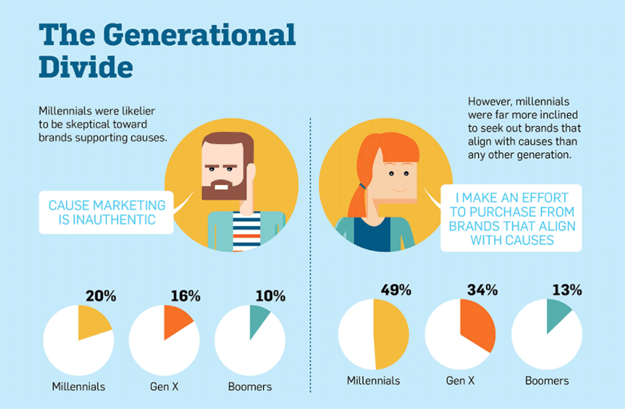The Why & How Behind Cause Marketing

by Amberly Dressler
15 Dec, 2017
Done well, cause-related marketing does not need to leave Web professionals with the unsettling feeling of leveraging charity for business gain.
The basic premise of cause marketing is when a for-profit business partners with a non-profit organization. The "cause" receives awareness and funds in exchange for the "marketing" entity associating itself with something people care about and likely generating more sales as a result.
Across demographics, people do not seem to believe cause marketing is authentic, yet many consumers (particularly millennials) make an effort to purchase from brands aligning themselves with causes ( source).

( Image source)
For these reasons, this is why organizations participate in cause marketing. The how behind cause marketing gets a bit more complicated. We've addressed five main steps organizations need to take:
1. Match Audiences
A marketing manager may think a charity they are particularly fond of is a good fit for their organizations, but they cannot skimp on understanding whether it truly aligns with their brand. One way (there are many) to tell is through an analytics system that provides audience interest information. If, for example, a large portion of the audience is interested in sports, they may be more inclined to support an organization related to sports such as those catering to under-served audiences. Likewise, if a large portion of the audience is interested in technology, they may be more inclined to support an organization related to STEM education, for example. It would be counter-productive to target new or existing customers outside of the interests shown within a company's audience analytics.

( Sample interests shown in Google Analytics.)
2. Monitor Reputation
Once a business partners with a non-profit their reputations may forever be aligned. Marketers will want to check social media accounts for both the organization and all of its upper management. While displaying personality on social is fine, brands will want to stay away from organizations and/or their executives who may take their social antics too far. Likewise, marketers can survey people within their target demographic regarding how they "feel" about that non-profit.
3. Time to Talk
At this point, it is ideal that a business and organization already have some relationship on which to form a partnership. If this is a "cold" call type approach, it will prove to be more difficult to initiate a conversation about the opportunity. The good news is most of the marketer's work is already done. They can present the information from step one to the non-profit, proving the audiences align. They can then share some of their own public sentiment about their brand by showing what types of messages are typically written about them on social media (using the same tactics in step two but for their own company). Also consider adding some compelling stats like these.
When reaching out to an organization they will likely want to know the proposed plan for revenue sharing and promotion ( here are some sample programs), so it is advised to seek legal counsel about how the profits will be split, accounted for and more.
4. Keep Talking
Cause marketing is certainly mutually beneficial, but neither party will want to feel taken advantage of. Lines of communication should always be open, and anything either party needs should be addressed such as high-resolution logos in order for each marketing team to promote the other. Transparency will also be key. If a marketer creates a Facebook post, for example, they can tag the organization as a partner so the non-profit is able to see the results of the post as well.
5. Create Content
Every promotion should include both organizations, and each marketing team should be doing equal amounts of promotion during the life of the campaign. It will likely be up to the brand's marketing manager (versus the charity's) to ensure a schedule of promotions is set, and everyone is aware of deadlines and elements such as which copy and photos to use as well as when to schedule the promotions. Along the way, brands will want to update audiences with feel-good stories, goals they want to reach and more. When the campaign is finished, stats and stories should be pulled to let audiences know their impact.
The basic premise of cause marketing is when a for-profit business partners with a non-profit organization. The "cause" receives awareness and funds in exchange for the "marketing" entity associating itself with something people care about and likely generating more sales as a result.
Across demographics, people do not seem to believe cause marketing is authentic, yet many consumers (particularly millennials) make an effort to purchase from brands aligning themselves with causes ( source).

( Image source)
For these reasons, this is why organizations participate in cause marketing. The how behind cause marketing gets a bit more complicated. We've addressed five main steps organizations need to take:
1. Match Audiences
A marketing manager may think a charity they are particularly fond of is a good fit for their organizations, but they cannot skimp on understanding whether it truly aligns with their brand. One way (there are many) to tell is through an analytics system that provides audience interest information. If, for example, a large portion of the audience is interested in sports, they may be more inclined to support an organization related to sports such as those catering to under-served audiences. Likewise, if a large portion of the audience is interested in technology, they may be more inclined to support an organization related to STEM education, for example. It would be counter-productive to target new or existing customers outside of the interests shown within a company's audience analytics.

( Sample interests shown in Google Analytics.)
2. Monitor Reputation
Once a business partners with a non-profit their reputations may forever be aligned. Marketers will want to check social media accounts for both the organization and all of its upper management. While displaying personality on social is fine, brands will want to stay away from organizations and/or their executives who may take their social antics too far. Likewise, marketers can survey people within their target demographic regarding how they "feel" about that non-profit.
- Have they heard of them?
- What do you they think of them?
- Would they be more inclined to buy from a brand that supports them?
3. Time to Talk
At this point, it is ideal that a business and organization already have some relationship on which to form a partnership. If this is a "cold" call type approach, it will prove to be more difficult to initiate a conversation about the opportunity. The good news is most of the marketer's work is already done. They can present the information from step one to the non-profit, proving the audiences align. They can then share some of their own public sentiment about their brand by showing what types of messages are typically written about them on social media (using the same tactics in step two but for their own company). Also consider adding some compelling stats like these.
When reaching out to an organization they will likely want to know the proposed plan for revenue sharing and promotion ( here are some sample programs), so it is advised to seek legal counsel about how the profits will be split, accounted for and more.
4. Keep Talking
Cause marketing is certainly mutually beneficial, but neither party will want to feel taken advantage of. Lines of communication should always be open, and anything either party needs should be addressed such as high-resolution logos in order for each marketing team to promote the other. Transparency will also be key. If a marketer creates a Facebook post, for example, they can tag the organization as a partner so the non-profit is able to see the results of the post as well.
5. Create Content
Every promotion should include both organizations, and each marketing team should be doing equal amounts of promotion during the life of the campaign. It will likely be up to the brand's marketing manager (versus the charity's) to ensure a schedule of promotions is set, and everyone is aware of deadlines and elements such as which copy and photos to use as well as when to schedule the promotions. Along the way, brands will want to update audiences with feel-good stories, goals they want to reach and more. When the campaign is finished, stats and stories should be pulled to let audiences know their impact.

Amberly Dressler
Head of analyst relations, public relations, customer advocacy (People Heroes), customer community, content marketing (full funnel/lifecycle), content operations and optimization, reputation management and social media. Leads a team of nine superstars to exceed our goals multi-fold.






